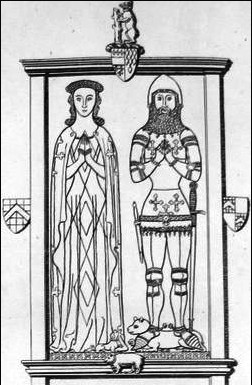
Ralph Neville, 1st Earl of WestmorlandEarl Marshal, was an English nobleman of the House of Neville.

Earl of Warwick is one of the most prestigious titles in the peerages of the United Kingdom. The title has been created four times in English history, and the name refers to Warwick Castle and the town of Warwick.

Richard Beauchamp, 13th Earl of Warwick was an English medieval nobleman and military commander.

Thomas de Beauchamp, 12th Earl of Warwick, KG was an English medieval nobleman and one of the primary opponents of Richard II.

Guy de Beauchamp, 10th Earl of Warwick was an English magnate, and one of the principal opponents of King Edward II and his favourite, Piers Gaveston. Guy was the son of William de Beauchamp, the first Beauchamp earl of Warwick, and succeeded his father in 1298. He distinguished himself at the Battle of Falkirk and subsequently, as a capable servant of the crown under King Edward I. After the succession of Edward II in 1307, however, he soon fell out with the new king and the king's favourite, Piers Gaveston. Warwick was one of the main architects behind the Ordinances of 1311, that limited the powers of the king and banished Gaveston into exile.

Thomas de Beauchamp, 11th Earl of Warwick, KG, sometimes styled as Lord Warwick, was an English nobleman and military commander during the Hundred Years' War. His reputation as a military leader was so formidable that he was nicknamed "the devil Warwick" by the French. In 1348 he became one of the founders and the third Knight of the Order of the Garter.

John Beauchamp, 1st Baron Beauchamp of Powick, KG, was an English nobleman and administrator. He was the son and eventual heir of Sir William Beauchamp of Powick in Worcestershire, Constable of Gloucester Castle, by his wife, Katherine Usflete, daughter and heiress of Sir Gerard de Usflete, a Member of Parliament for Yorkshire in 1401.

Margaret Stafford was the daughter of Hugh de Stafford, 2nd Earl of Stafford, and Philippa de Beauchamp. She was the first wife of Ralph Neville, 1st Earl of Westmorland, and the grandmother of the 2nd Earl.
Events from the 1310s in England.
Events from the 1360s in England.

John de Vere, 7th Earl of Oxford was the nephew and heir of Robert de Vere, 6th Earl of Oxford who succeeded as Earl of Oxford in 1331, after his uncle died without issue.

Katherine Mortimer, Countess of Warwick (c. 1314 – 4 August 1369) was the wife of Thomas de Beauchamp, 11th Earl of Warwick KG, an English peer, and military commander during the Hundred Years War. She was a daughter and co-heiress of Roger Mortimer, 1st Earl of March and Joan de Geneville, Baroness Geneville.
Alice de Toeni, Countess of Warwick was a wealthy English heiress and the second wife of Guy de Beauchamp, 10th Earl of Warwick, an English nobleman in the reign of kings Edward I and Edward II. He was one of the principal opponents of Piers Gaveston, a favourite of Edward II. Alice married three times; Guy was her second husband.
Isabel de Verdun, Baroness Ferrers of Groby was an heiress, who was related to the English royal family as the eldest daughter of Elizabeth de Clare, herself a granddaughter of King Edward I of England. When she was a child, Isabel was imprisoned in Barking Abbey, along with her mother and half-sister, after her stepfather had joined the Earl of Lancaster's ill-fated rebellion against King Edward II. Her husband was Henry Ferrers, 2nd Baron Ferrers of Groby.

Lady Alice Holland, Countess of Kent, LG, formerly Alice FitzAlan, was an English noblewoman, a daughter of the 10th Earl of Arundel, and the wife of the 2nd Earl of Kent, the half-brother of King Richard II. As the maternal grandmother of Anne de Mortimer, she was an ancestor of kings Edward IV and Richard III, as well as King Henry VII and the Tudor dynasty through her daughter Margaret Holland. She was also the maternal grandmother of Joan Beaufort, Queen of Scots.
Isabella de Beauchamp, Lady Kidwelly, Baroness Despenser, was an English noblewoman and wealthy heiress.

Roger de Clifford, 5th Baron de Clifford, ninth Lord Clifford, fifth Baron of Westmoreland, was the son of Robert de Clifford, 3rd Baron de Clifford, second son of Robert de Clifford, 1st Baron de Clifford (1273–1314), the founder of the northern branch of the family. His mother was Isabella, daughter of Maurice, 2nd Lord Berkeley. He succeeded his elder brother, Robert de Clifford, 4th Baron de Clifford in 1350, on which day he made proof of his age.

Guy Bryan, 1st Baron Bryan, KG was an English landowner, military and naval commander, courtier, diplomat, and administrator.

Henry Ferrers, 2nd Baron Ferrers was the son of William Ferrers, 1st Baron Ferrers of Groby and his wife Ellen. Henry Ferrers has been described by one recent historian as "arguably the most successful member of his family" on account of his being the only one, in six generations, to have succeeded to his patrimony as an adult, thus "protecting his inheritance from the hazards of wardship".

William Ferrers, 3rd Baron Ferrers of Groby (1333–1371) was a Leicestershire-based nobleman in fourteenth-century England who took part in some of the major campaigns of the first part of the Hundred Years' War. The eldest of two sons to Henry Ferrers, 2nd Baron Ferrers of Groby (d. 1343), and Isabel de Verdun, daughter of Theobald de Verdun, 2nd Baron Verdun, William was ten years old when he succeeded his father to the Barony.














